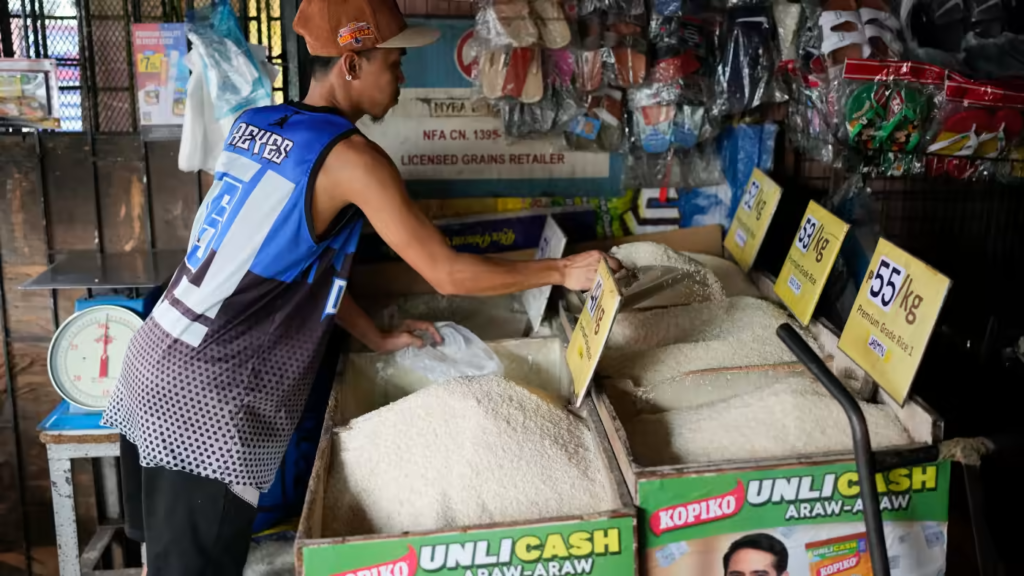Tags
Asia’s rice squeeze after India export ban: 4 things to know
Market turmoil, government action, inflation jitters follow supply fears

A vendor sells rice at a store in Quezon City, the Philippines, on Aug. 14. Countries everywhere are scrambling to secure rice after a partial ban on exports by India cut supplies by roughly a fifth. © AP
TOKYO — India’s decision last month to ban exports of rice sent shock waves through the Asian market for the staple food, inflating August prices by nearly 10% to a 15-year high, according to the U.N. Food and Agriculture Organization’s All Rice Price Index.
Asia produces and consumes 90% of the global supply of the grain, and the region’s governments have braced for inflation and supply concerns in a trade already hit by extreme weather and fertilizer shortages. The Philippines imposed a cap on rice prices at the start of September and soon after said it might review rice import tariffs as rising costs for the carbohydrate disproportionately affect poor households.
As the crop-threatening El Nino weather pattern continues to develop, casting a dark cloud over this winter’s market prospects, here are four things to know about the squeeze on rice in Asia.
Why did India ban exports?
The world’s largest rice exporter was mainly sending its rice to countries like Vietnam and the Philippines. But with unfavorable weather undermining harvests, prices running at their highest level in years and a national election coming in 2024, New Delhi opted to prioritize domestic consumption and lower prices at home.
Officially, the Ministry of Consumer Affairs, Food and Public Distribution said it prohibited exporting most white rice because “domestic prices of rice are on an increasing trend.”
Why is the supply crunch so severe?
The Indian embargo disrupted rice markets across the region.
In Thailand, the world’s second-largest rice exporter, domestic milled rice prices jumped nearly 20% the week after India’s statement, hitting 21,000 baht ($597) per tonne, while export prices hit an 11-year high.
Within Asia, the Philippines appears most vulnerable to higher food prices, according to a report by Nomura analysts, with net food imports comprising over 2% of its gross domestic product.

Meanwhile, a report by the Asian Development Bank earlier this year estimated that global rice demand will increase by 30% by 2050. That surge will come, Nomura said, even as rice yield growth declines in many Asian countries as they get hit by more frequent extreme weather events. In addition, limited public investment in rice production, research and development will take a toll. “The potential demand and supply gap can lead to high rice prices in the medium to long term,” Nomura analysts wrote.
What about the impact of climate change?
The most recent forecast from the International Research Institute (IRI) for Climate and Society at Columbia University indicates an El Nino — a warming weather pattern accompanied by storms in some places and droughts in others — will persist through the Northern Hemisphere this winter. Forecasters are confident that the phenomenon will be “strong.”
Thailand expects El Nino to disrupt its rainy season and cast a shadow over harvests for November shipments.
Weather conditions resulting from climate change are also destabilizing the rice supply. China, another major rice exporter, experienced severe torrential rains in July in several locations, including Beijing, and flood damage had a major impact on rice production.
Mamun Abdullah — a senior research analyst at the market, trade, and institutions unit of the International Food Policy Research Institute — predicts that irregular weather “will create further price volatility that can last until the next cropping season arrives.”
What does this mean for consumers and inflation?
The IFPRI’s Abdullah says fears of high inflation and price volatility have haunted the rice trade for some time, given spikes in other food commodities like wheat as a result of the war in Ukraine.
“Our experience from the 2008 food price crisis [when India imposed an export ban on broken rice and then a 20% levy] indicates such market reaction (rising prices) is very plausible,” Abdullah said.
“When large exporting countries try to insulate the domestic price of key commodities by restricting export,” an IFPRI study says, “they in turn contribute to further volatility in world prices.”
https://asia.nikkei.com/Business/Markets/Commodities/Asia-s-rice-squeeze-after-India-export-ban-4-things-to-knowPublished Date: September 14, 2023





